|
|
|
Sort Order |
|
|
|
Items / Page
|
|
|
|
|
|
|
| Srl | Item |
| 1 |
ID:
089984
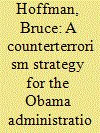

|
|
|
|
|
| Publication |
2009.
|
| Summary/Abstract |
This article assesses the scope and nature of the current terrorist threat to the United States and suggests a strategy to counter it. Al-Qaeda continues to pose the most serious terrorist threat to the U.S. today. If the September 11, 2001 attacks have taught us anything, it is that al-Qaeda is most dangerous when it has a sanctuary or safe haven from which to plan and plot attacks. Al-Qaeda has acquired such a sanctuary in Pakistan's Federal Administered Tribal Areas (FATA) and its North-West Frontier Province (NWFP) and surrounding environs. Accordingly, the highest priority for the new American presidential administration must be to refocus our-and our allies'-attention on Afghanistan and Pakistan, where al-Qaeda began to collapse after 2001, but has now re-grouped. This will entail understanding that al-Qaeda and its local militant jihadi allies cannot be defeated by military means alone. Success will require a dual strategy of systematically destroying and weakening enemy capabilities-that is, continuing to kill and capture al-Qaeda commanders and operatives-along with breaking the cycle of terrorist recruitment among radicalized "bunches of guys" as well as more effectively countering al-Qaeda's effective information operations. The U.S. thus requires a strategy that harnesses the overwhelming kinetic force of the American military as part of a comprehensive vision to transform other, non-kinetic instruments of national power in order to deal more effectively with irregular and unconventional threats. This article first discusses the scope and details of the terrorist threat today and then proposes a counterterrorism strategy for the new presidential administration. It focuses first on creating a micro approach to address the deteriorating situation in both Afghanistan and Pakistan. It then considers the requirements of a broader macro strategy to counter terrorism and insurgency.
|
|
|
|
|
|
|
|
|
|
|
|
|
|
|
|
| 2 |
ID:
058493
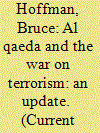

|
|
|
| 3 |
ID:
056788
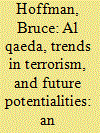

|
|
|
| 4 |
ID:
122424
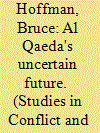

|
|
|
|
|
| Publication |
2013.
|
| Summary/Abstract |
This article considers the current state of the Al Qaeda terrorist movement and its likely future trajectory. It considers the principle assumptions both today and in the past about Al Qaeda and how they affect our understanding of the movement and the threat that it poses; Al Qaeda's current capacity for violence; and its ability to plan strategically and implement terrorist operations. The article further identifies nine key change drivers that will likely determine Al Qaeda's fate in the years to come before concluding that, even while the core Al Qaeda group may be in decline, Al Qaeda-ism, the movement's ideology, continues to resonate and attract new adherents. In sum, it argues that Al Qaeda remains an appealing brand most recently and most especially to extremist groups in North and West Africa and the Levant.
|
|
|
|
|
|
|
|
|
|
|
|
|
|
|
|
| 5 |
ID:
065595
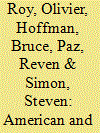

|
|
|
|
|
| Publication |
2000.
|
| Description |
p.156-172
|
|
|
|
|
|
|
|
|
|
|
|
|
|
|
|
| 6 |
ID:
098982
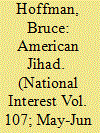

|
|
|
| 7 |
ID:
047837
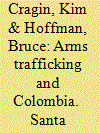

|
|
|
|
|
| Publication |
Santa Monica, Rand Corporation, 2003.
|
| Description |
xxvi, 81p.
|
| Standard Number |
0833031449
|
|
|
|
|
|
|
|
|
|
|
|
Copies: C:1/I:0,R:0,Q:0
Circulation
| Accession# | Call# | Current Location | Status | Policy | Location |
| 047169 | MR-1468-DIA/CRA 047169 | Main | On Shelf | General | |
|
|
|
|
| 8 |
ID:
106612
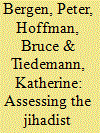

|
|
|
|
|
| Publication |
2011.
|
| Summary/Abstract |
Al Qaeda and allied groups continue to pose a threat to the United States. Although it is less severe than the catastrophic proportions of a 9/11-like attack, the threat today is more complex and more diverse than at any time over the past nine years. Al Qaeda or its allies continue to have the capacity to kill dozens, or even hundreds, of Americans in a single attack. A key shift in the past couple of years is the increasingly prominent role in planning and operations that U.S. citizens and residents have played in the leadership of Al Qaeda and aligned groups, and the higher numbers of Americans attaching themselves to these groups. Another development is the increasing diversification of the types of U.S.-based jihadist militants, and the groups with which those militants have affiliated. Indeed, these jihadists do not fit any particular ethnic, economic, educational, or social profile. Al Qaeda's ideological influence on other jihadist groups is on the rise in South Asia and has continued to extend into countries like Yemen and Somalia; Al Qaeda's top leaders are still at large, and American overreactions to even unsuccessful terrorist attacks arguably have played, however inadvertently, into the hands of the jihadists. Working against Al Qaeda and allied groups are the ramped-up campaign of drone attacks in Pakistan, increasingly negative Pakistani attitudes and actions against the militants based on their territory, which are mirrored by increasingly hostile attitudes toward Al Qaeda and allied groups in the Muslim world in general, and the fact that erstwhile militant allies have now also turned against Al Qaeda. This article is based on interviews with a wide range of senior U.S. counterterrorism officials at both the federal and local levels, and embracing the policy, intelligence, and law enforcement communities, supplemented by the authors' own research.
|
|
|
|
|
|
|
|
|
|
|
|
|
|
|
|
| 9 |
ID:
172816
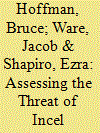

|
|
|
|
|
| Summary/Abstract |
In recent years, increasingly serious incidents of violence have been committed by young men predominantly in the United States and Canada who self-identify as incels (involuntary celibates). Although these attacks often specifically target women, the principal source of their animus, men as well as children have been among the casualties in the series of shootings and vehicular homicides that have occurred at universities, high schools, and on city streets. Although, the incel worldview is not obviously political, its core ethos entails the subjugation and repression of a group and its violence is designed to have far-reaching societal effects. Accordingly, incel violence arguably conforms to an emergent trend in terrorism with a more salient hate crime dimension that necessitates greater scrutiny and analysis—especially as it spreads to Europe and shows similarities to and has nascent connections with other terrorist movements.
|
|
|
|
|
|
|
|
|
|
|
|
|
|
|
|
| 10 |
ID:
173846
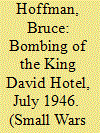

|
|
|
|
|
| Summary/Abstract |
On 22 July 1946, the Irgun Zvai Le’umi (National Military Organization), a Jewish terrorist organization opposed to Britain’s continued rule of Palestine, bombed Jerusalem’s King David Hotel. The incident has always been controversial given the fact that the facility was not an ordinary hotel, but also the nerve center of British rule over that country — housing its military headquarters, intelligence stations, and government secretariat. Further, at the time it was claimed that warnings were issued to evacuate the hotel that British officials callously ignored. This article addresses three key three questions surrounding the bombing: Was the King David Hotel in fact a legitimate military target? Were warnings in fact given to evacuate the hotel? And, if so, why wasn’t the hotel evacuated? The answers, while critical in reaching an accurate accounting and factual understanding of a highly controversial event, interestingly also shed light on the efficacy and morality of terrorism as an instrument of national liberation and agent of political change.
|
|
|
|
|
|
|
|
|
|
|
|
|
|
|
|
| 11 |
ID:
087387
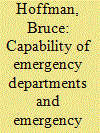

|
|
|
|
|
| Publication |
2009.
|
| Summary/Abstract |
Despite the potential array of atypical medical contingencies that the U.S. health system could face if confronted with mass-casualty events (MCE) resulting from terrorist attacks using conventional explosives, American hospitals are neither sufficiently funded nor prepared to effectively respond to such potentialities. Historically, the bias in most MCE planning has been toward the worst case scenarios, often entailing weapons of mass destruction (such as chemical, biological, radiological, and nuclear weapons), on the assumption that any other MCEs, including those where conventional explosions are used, can simply be addressed as a lesser-included contingency. Yet, MCEs present unique medical challenges that to date the United States has mercifully rarely experienced but nonetheless must be prepared for.
|
|
|
|
|
|
|
|
|
|
|
|
|
|
|
|
| 12 |
ID:
020619
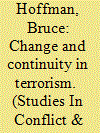

|
|
|
|
|
| Publication |
2001.
|
| Description |
417-428
|
|
|
|
|
|
|
|
|
|
|
|
|
|
|
|
| 13 |
ID:
057619
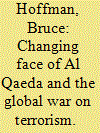

|
|
|
|
|
| Publication |
Nov-Dec 2004.
|
|
|
|
|
|
|
|
|
|
|
|
|
|
|
|
| 14 |
ID:
079848


|
|
|
|
|
| Publication |
2007.
|
| Summary/Abstract |
More important than the potential geographical spread of a specific weapon, tactic or expertise is the emulation or inspiration of the 'culture' surrounding a terrorist or insurgent movement. This article argues that a 'cult of the insurgent' has arisen as a result of the aura of success surrounding both the Iraqi insurgents in their ongoing confrontation with the United States military and Hezbollah in its confrontation in the northern summer of 2006 with Israel. Further, this 'cult of the insurgent' will prove the most critical factor in inspiring, motivating and animating the spread of lethal and destructive expertise among other terrorist and insurgent groups worldwide. In the future, therefore, our adversaries will likely conclude that the best and most cost-effective means to confront either a superpower or the superior, conventional military forces of an established nation-state is through a campaign reliant on terrorist and insurgent tactics involving stand-off attacks utilising IEDS (improvised explosive devices) and portable missiles and mortars1
|
|
|
|
|
|
|
|
|
|
|
|
|
|
|
|
| 15 |
ID:
070274
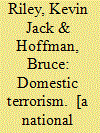

|
|
|
|
|
| Publication |
Santa Monica, Rand Corporation, 1995.
|
| Description |
xi, 66p.
|
| Standard Number |
083301627X
|
|
|
|
|
|
|
|
|
|
|
|
Copies: C:1/I:0,R:0,Q:0
Circulation
| Accession# | Call# | Current Location | Status | Policy | Location |
| 036586 | 363.320973/RIL 036586 | Main | On Shelf | General | |
|
|
|
|
| 16 |
ID:
137158
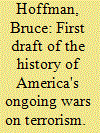

|
|
|
|
|
| Summary/Abstract |
This research note attempts to map the Al Qaeda movement's trajectory from the 11 September 2001 attacks to the stunning events of 2014—which saw the continued rise of the Islamic State of Iraq and Syria (ISIS), its expulsion from the Al Qaeda movement, followed by ISIS's stunning thrust into Iraq, its declaration of a caliphate, and the re-engagement of American military forces in this region. It attempts to place in context the Al Qaeda movement's evolution to explain why the United States under President Barack Obama, despite hopes and expectations to the contrary, is still enmeshed in the war on terrorism proclaimed by George W. Bush over a decade ago.
|
|
|
|
|
|
|
|
|
|
|
|
|
|
|
|
| 17 |
ID:
092304
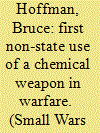

|
|
|
|
|
| Publication |
2009.
|
| Summary/Abstract |
This article presents research conducted by the author in Sri Lanka to verify the first non-state use of a chemical weapon in warfare. This 1990 incident involved a primitive chemical attack perpetrated by the Liberation Tigers of Tamil Eelam (the LTTE or Tamil Tigers) on a Sri Lankan Armed Forces (SLAF) encampment in East Kiran, in the Batticaloa district of Sri Lanka. The article first describes the incident itself, before providing a brief description of the LTTE, its background, and the influence of its leader, Velupillai Prabhakaran. The article then analyzes the attack and places it within the context of theories about potential terrorist and insurgent use of unconventional weapons, such as chemical warfare agents. The research reported here is of interest not only because of the unique, opportunistic dimension of the attack, but also because its conclusions challenge the conventional wisdom about likely terrorist and insurgent use of these unconventional weapons and sheds new light on their interest and intentions in employing such weapons and tactics.
|
|
|
|
|
|
|
|
|
|
|
|
|
|
|
|
| 18 |
ID:
078060
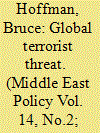

|
|
|
|
|
| Publication |
2007.
|
| Summary/Abstract |
Five-and-a-half years ago, 19 terrorists hijacked four airplanes and changed the course of history. Just as we underestimated al-Qaeda then, we risk repeating the same mistake now. Al-Qaeda today is frequently spoken of as if it is in retreat: a broken and beaten organiza-tion, its leadership living in caves, cut off somewhere in remotest Waziristan incapable of mounting further attacks on its own and instead having devolved operational authority either to its various affiliates and associates or to entirely organically-produced, homegrown, terrorist entities. Isolated and demoralized, al-Qaeda is thus imagined to have been reduced to a purely symbolic role, inspiring copycat terrorist groups, perhaps, but lacking any operational capability of its own - a toothless tiger.
"Al-Qaeda," President Bush declared last October, "is on the run." But al-Qaeda, in fact, is on the march. It has regrouped and reorganized from the setbacks meted out to it by the United States and our coalition partners and allies during the initial phases of the global war on terrorism (GWOT)and is marshalling its forces to continue the epic struggle begun more than ten years ago. More than ever, al-Qaeda's revival reminds us of our continued failure to heed the advice of the Chinese strategist Sun Tzu. "If you know the enemy and know yourself," he famously advised centuries ago, "you need not fear the results of a hundred battles." Yet, if there has been one consistent theme in both America's war on terrorism and our melancholy involvement in Iraq, it is our serial failure to fulfill Sun Tzu's timeless admonition. The Bush administration's new strategy to "surge" 21,000 American troops into Iraq is the latest fundamental misreading of our enemy's mindset and intentions.
|
|
|
|
|
|
|
|
|
|
|
|
|
|
|
|
| 19 |
ID:
009678
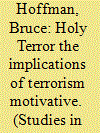

|
|
|
|
|
| Publication |
Oct-Dec 1995.
|
| Description |
271-284
|
|
|
|
|
|
|
|
|
|
|
|
|
|
|
|
| 20 |
ID:
070605
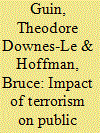

|
|
|
|
|
| Publication |
Santa Monica, Rand Corporation, 1993.
|
| Description |
xiii, 93p.
|
| Standard Number |
0833013793
|
|
|
|
|
|
|
|
|
|
|
|
Copies: C:1/I:0,R:0,Q:0
Circulation
| Accession# | Call# | Current Location | Status | Policy | Location |
| 034883 | 363.320973/GUI 034883 | Main | On Shelf | General | |
|
|
|
|
|
|
|
|
|